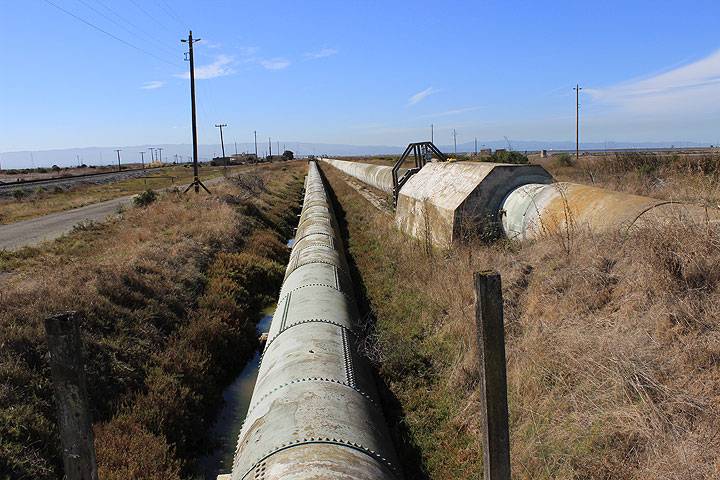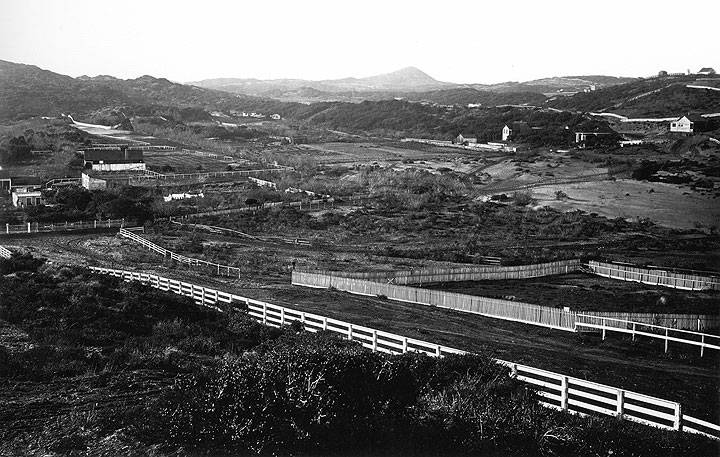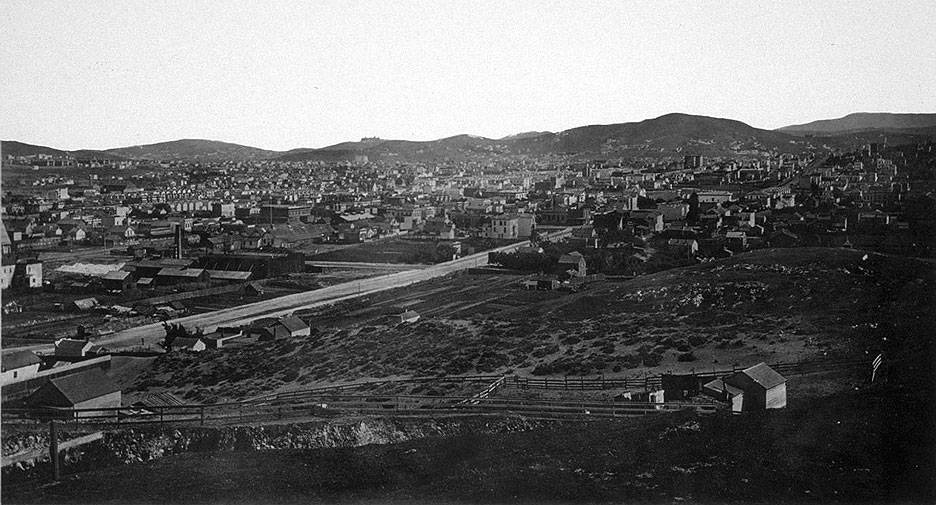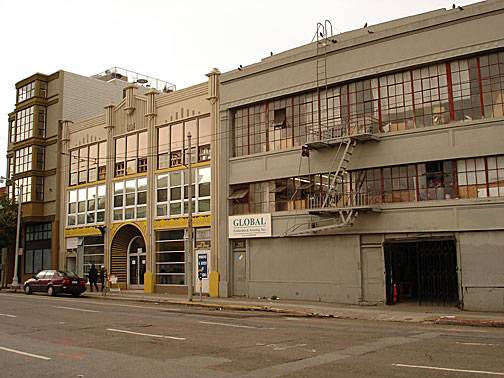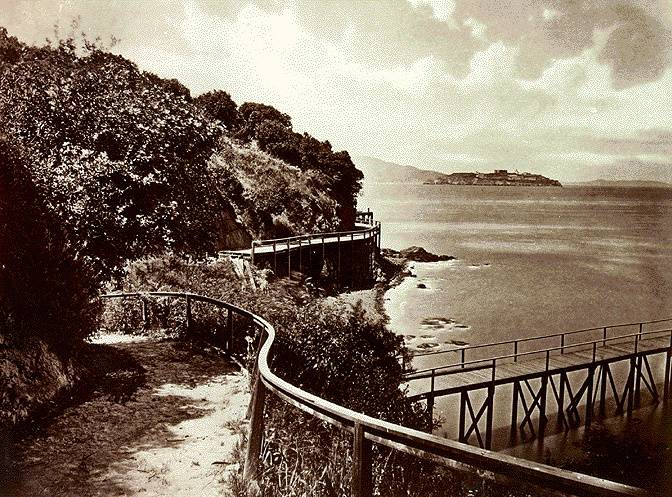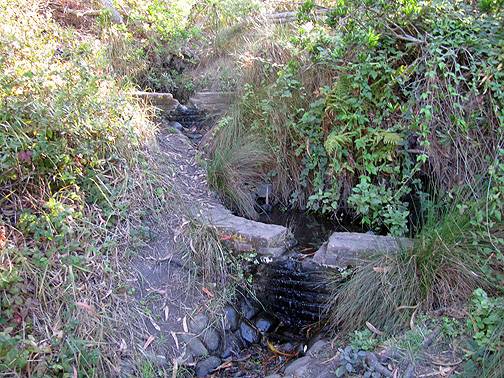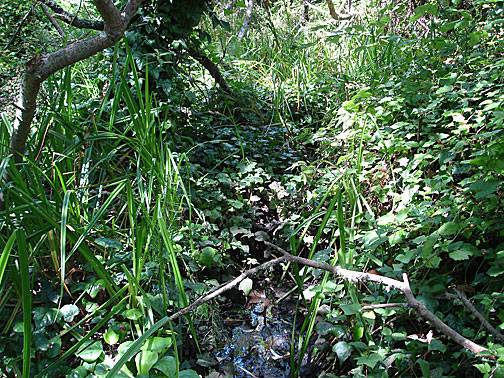San Francisco's Clean Little Secret
Historical Essay
by Joel Pomerantz
DISCLAIMER: There is now (2010) very strong evidence surfacing that some of the historical assumptions that calculations and details in this article were based on need to be reinterpreted due to further scholarship. Specifically, although many maps show one, it appears that there was never an enduring freshwater lake in the Mission District. It turns out that "manantial" means spring-fed, rather than merely any freshwater. The waterways in the Mission area were all stream-fed, and Anza's journals make it clear that "laguna de manantial" was a reference to Washerwoman's Lagoon (earlier called Laguna Pequeña) in what is now the Marina and Cow Hollow areas. Anza passed this on his way to search for a site for the mission and thus included it in the same description. However it was not in the same geographic area. Full update here.
San Francisco's water supply coming from the Hetch Hetchy reservoir in Yosemite passes through these pipes near the Dumbarton Bridge in the East Bay.
Photo: Chris Carlsson
| San Franciscans are hardly aware that their drinking water arrives at their sinks by 165 miles of pipeline coming from controversial Hetch Hetchy Reservoir. They are even less aware of the clean water flowing beneath the pavement. Due to the pipeline’s sensitivity to seismic activity, the availability of water can change on a moment’s notice. How San Francisco came to rely on this pipeline is a story marred by power struggles and environmentally detrimental behavior by a wealthy few. Initially a vision to supply clean alpine water and low-cost hydroelectric power to Northern Californians, Hetch Hetchy reservoir is now an expensive necessity due to contamination of local waters by negligent development in San Francisco’s hills. |
Surrounded by the salty ocean, San Franciscans take as a given the need for fresh water drawn from mountains on the far side of the state. Hetch Hetchy reservoir, located in Yosemite National Park on the Tuolumne River, is our main source. The Tuolumne, combined with creeks in counties nearer San Francisco, supply 95% of the water we use for our residences, industries, and irrigation. We have this water in our taps as a result of more than a century of San Francisco’s political dominance over an arid region, where control of water is indeed the key to life. Spending billions, we take the water 165 miles from a mostly dry area to distribute among ourselves.
The oddest part of this arrangement is not the extravagance of our resource grab, but the redundancy. It is not clear that San Francisco needs this water as much as we claim to. Unbeknownst to most San Franciscans, our little seven square miles contain a remarkable geologic feature, a significant wellspring of quality water. At one time, local sources were our only supply and were taken for granted in their own right. Now, the gushing output of San Francisco springs is diverted into our sewers, replaced in our homes by other sources of water that are more susceptible to central control. Our relationship to water has been determined as much by revenue streams as by streams of water.
As world population surges beyond the levels that planetary fresh water can provide for, the groundwater of San Francisco will quickly become more valuable than oil. If we look closely at what we have and use our “native” creativity, we could establish our city as a self-sufficient user of sustainable local resources, accomplishing the transition over a relatively short period of time. We could restore some of San Francisco’s natural lakes and expose buried creeks to the daylight. We could possibly even return Hetch Hetchy Valley—which environmentalist John Muir compared favorably to the beauty of Yosemite Valley—to its original condition.
Water resources have been notably absent from the platform planks of election campaigns, even those of recent progressive candidates. Yet we do not need to start from scratch. Best practices are already codified, many studies have been done, a master plan has even been written (and then shelved) by the Public Utilities Commission. At this point, we need a broader education about our heretofore secret water options, and a cooperative path into the fragile future. It is time to insert this pivotal issue into the local political agenda. Then we need to fight like hell to steer our new policies past the pitfalls of profit and corporate control, which have so thoroughly poisoned our present system.
Aqueous Ubiquitous?
Here, in our peninsular paradise, we see, feel, and use water daily in a hundred forms. The tide caresses our shore, three-fourths of our border with the outside world. Fishing lines, swaddled in damp fog, are dangled off generations of piers into the salty bay. With each winter storm, surf pounds Ocean Beach leaving patterned blips on the seismograph at the Randall Museum. On sunny days, the mists and sounds of fountain spatter make our public spaces seem grander. Parks and golf courses are coaxed green by old rain sucked from the ground.
Rain washes oil, left on the concrete by manifold thousands of dripping cars, into the sewers. Clay skeet falls dayglo and shattered from the Pacific Rod and Gun Club into fresh Lake Merced, once an estuarial inlet of the sea. Gurgling through colorful pipes, water extracts acrid and metallic chemical discard from refineries and circuit board manufacturers, mostly now banned from direct release into the bay by policies developed in the past few decades.
A Chinatown fishmonger sprays down the scented sidewalk at closing time. Meanwhile, inside, the president appears on a television floated from its Asian assembly line in an airtight container over rising seas. He disingenuously declares a national effort to harness hydrogen energy from “abundant” water.
We charge ourselves monthly to draw clean water into our homes. It swirls to the left or right down our toilets, sloshes grime off dinnerware in our sinks—water used once and then thrown away. By opening the faucet, we pull it effortlessly from distant reservoirs through aging pipelines and brittle concrete aqueducts snaking miles over active faults and under bay sediments. Convinced our taps are contaminated, we suckle expensive “pure” water from bottles made with estrogen-mimicking plastic contaminants. We somehow derive a sense of purity from famous springs named on the label, though it is often simply trucked in from distant spigots dispensing worse water than our own municipal taps.
But do we really understand the water around us? While plentiful, most of it presents a great challenge to use, because of sea salt. To drink and manufacture, irrigate and bathe, we require low-saline fresh water—traditionally extracted from rivers. It would seem that all we need to do, if we wish to drink fresh water, is find a sweet water source such as a river.
Where is the nearest river? If you live in San Francisco and want to escape the pressures of city life, you have probably gone north for a visit to the Russian River region, or east to the Stanislaus River in the Central Valley. Probably you have seen the Delta of the Sacramento and San Joaquin Rivers, where High Sierra snow melt meanders at sea level through drained tracts like Bethel “Island.” These two rivers, the Sacramento and the San Joaquin, join forces and flow through the Carquinez Straits, bringing most of Northern California’s precious fresh surface water to commingle with the salty tides of San Pablo Bay and the San Francisco estuary itself, which we refer to as simply “the Bay.”
And, indeed, many Bay Area municipalities draw their drinking water from these rivers, always threatened by salt incursion as reduced river volume brings salt water farther upstream.
Some of that reduction of flow is due to San Francisco’s use of Hetch Hetchy. Our municipal water leaves the river system high in the Sierra Nevada, where three 75-year-old dams arrest the Tuolumne headwaters. These reservoirs gather water from a prime watershed more than twelve times the size of San Francisco. They pool the annual cycles of snow melt into drowned granite valleys now called Lake Eleanor, Cherry Lake, and Hetch Hetchy.
In a sense, we have exactly what we need; a fresh sweet river can be found by simply turning the faucet. When we do this trick, we get even more than that river, because the nearer Pilarcitos Creek and Alameda Creek watersheds make their contributions to our system from San Mateo and Alameda Counties, respectively. Turn the tap, get a river and two creeks. Spared the journey they once took along winding, lush banks, “our” water is diverted into the artificial rivers of the Hetch Hetchy Project before being distributed within San Francisco through 1,200 miles of water mains.
On the way, it slakes the thirst of about 4 million households and businesses in dozens of Bay Area municipalities—and millions of other users in other parts of California. Residential and industrial users of northern watersheds have addresses as far away as Los Angeles. A statewide system of aqueducts brings Central Valley water to the foot of the Tehachapis, hundreds of miles south of San Francisco, where it is pumped over the mountains into the even drier and far thirstier L.A. basin.
Money and power motivated entrepreneurial engineers to establish the complex Hetch Hetchy system. However, the earliest water sources for our peninsular village-turned-boomtown were right here in our lowlands and along the slopes of Twin Peaks. Some of these sources are easily perceptible—and some are thoroughly hidden. In fact, San Francisco has a remarkable native water source that is so out of sight and mind that we may as well call it a secret.
Mystery Upwelling
Into our briny city we bring potable supplies of anywhere from 75 to 100 million gallons a day. We also enjoy seasonal rains. Adding to those, water burbles up through our geologic substrate. While it is easy to see the reservoirs, aqueducts, and delivery trucks importing water, and natural to accept the rains and their contribution to the water tables, our unusual—though productive—springs and seeps have somehow evaded general notice. Unless you have walked Caselli Street or Pemberton Steps in the early morning quiet, you have probably never heard the babbling brook in the sewer. And if you have, you may have thought it the result of early risers showering. But it is, in fact, Dolores Creek.
Those San Franciscans with a more intimate sense of history talk about its creeks—Lobos, Islais, and Mission Creeks being the best known. These and other surface creeks and tributaries flowed unimpeded in the city’s early decades. Spanning many centuries before that, five or six permanent villages were located along their banks. These are not seasonal creeks. The flowing surface waterways of San Francisco’s past were year-round affairs, a detail that can be difficult to comprehend in a city which receives no rain for more than half of each year. In an article I wrote in 1994 about the “Wiggle,” a stream-flattened valley favored by bicyclists intent on bypassing hills, I mistakenly implied that Sans Souci Creek flowed only in the wet seasons. I never received a single correction, despite the evidence presented (shortly after publication) by a construction hole left gaping all summer at Scott and Haight Streets, where fresh running water could always be seen.
Valley through which "The Wiggle" passes in today's urban landscape.
Photo: Carleton Watkins, 1866, taken from Orphan Asylum near Mint Hill; Private Collection, San Francisco, CA
View from "Reservoir Hill" (now Mint Hill) looking westerly across Castro District, c. 1868.
Photo: Provenance unknown
What we forget, standing on impermeable pavement* is that water still exists beneath these streets, developments, and sandy lots. What once flowed in surface channels, though now buried in the ground or steered into sewer pipes, is still there somewhere. Tens of millions of gallons of fresh water each day (probably over three million just in the North Mission area) flow right below our feet from artesian springs of potable water. ‘Artesian’ is the term for sources that rise above the water table to the surface due to their own hydrologic pressure, needing no pumping.
Adding yet another layer to the mystery, massive surges of groundwater, much of it potable, travel continuously just beneath us from related “subartesian” sources that even historically never came fully to the surface. We easily overlook these “creeks” since they have never come into view to receive formal names.
If people think about local groundwater they generally think of the Westside Basin aquifer, because it is visible where its water table meets the surface at Lake Merced. The Westside Basin gets its water from rain, irrigation runoff, and other local, seasonal sources descending through the sand, soil, and fractured rock. It needs the rain for replenishment. In contrast, the fresh spring waters indefatigably flowing on the eastern slopes of Twin Peaks are a wondrous geologic feature, of unknown origin and potentially great benefit to the city. This water comes in quantities and seasons unlikely to be associated with local rains. Further study is needed to determine its ultimate source.
Between the scores of true artesian springs and the city’s underground flows fed by the same sources, San Francisco has, heading through our soils and sewers to the bay, enough water to supply many, or most, of our needs. With the Westside Basin rainwater aquifer added to these remarkable east slope sources, it appears that graywater recycling and treatment technology, along with conservation, could tip the balance to make meeting our entire municipal thirst feasible—relying only on local sources.
The Hayes River
Though ambling slowly, the mighty Hayes River is wide and voluminous, spreading through the alluvial sediments, bay muds, and landfill under the Civic Center and Downtown neighborhoods with a hydromorphology not unlike Florida’s everglades. It broadsides Market Street, encountering a long concrete subway tunnel that interrupts its gait. So copious are the waters of the Hayes that, to protect their investment from damage, BART runs “de-watering” pumps day and night in the Powell Street BART station. Removing, each week, 2.5 million gallons of tested, high-quality, potable groundwater (into the sewer!) the transit agency keeps the Hayes from flooding the tracks.
The Hayes, then, is our nearest natural river, a dispersed underground flow that descends through Hayes Valley from “headwaters” (more precisely, hundreds of upwellings, springs, and seeps) in the area near Lone Mountain and the University of San Francisco, and also along the hillsides of Alamo Square. On average, the river is about fifteen feet below surface, and much deeper and wider than most surface rivers. It finally meets the surface South of Market, where it enters the bay beneath China Basin and the even-numbered piers. Originally, it came to the surface in a marsh at Mission and Seventh Streets. The extent of this slow fluid influx is such that hundreds of landowners along this waterway originally used private wells, built right into their foundations, to supply all their water needs.
These warehouses at Howard and Langton Alley are sinking steadily into the marsh, thanks to the flowing Hayes River below the surface.
Photo: Chris Carlsson
A few buildings, such as the Olympic Club headquarters at 524 Post Street, and the California Automobile Association on Van Ness Avenue, still use Hayes water today. Many Civic Center buildings employ full-time pumping operations to keep their basements dry. The public fountains at United Nations Plaza and Fillmore Center are also fed by the waters of the Hayes.
The Hayes River still delivers quality, drinkable water to many areas. In the 1800s its wells, along with those tapping the Mission Creek water table, supplemented Lobos Creek in the Presidio to meet the needs of a growing city. Lobos Creek supplied San Francisco as the city’s main Gold Rush water source from 1851 to 1895, through an enterprise named Mountain Lake Water Company.
Mountain Lake Water Company flume wraps around Black Point (today's Fort Mason) in the 1870s. Built to carry water from Mountain Lake in the Presidio, it brought water around the coastal bluffs, past Ft. Mason, and to the pumping station at the the foot of Van Ness Avenue. It was then pumped to the first large reservoir in SF built in 1859, the Francisco Reservoir which sat at Bay and Hyde Street.
Photo: Private Collection, San Francisco, CA
Most of us go along unaware of these precious naturally flowing wonders, more concerned about what our guests wish to drink than with the specific source of the substance on which we depend. Even those of us devoted to environmental efforts usually overlook the native wellsprings of our coastal ridge formations.
More Than a Drop to Drink
We have found, much closer, one river and two creeks—Hayes, Mission, Lobos. Serving water to locals for ages, they were adopted by new Spanish- and English-speaking arrivals and then by the polyglot fortune hunters of the Gold Rush, all long before the Hetch Hetchy system was set up for its centralized dispensing of water and hydroelectric power. These local sources, something of a secret today, produced sufficient potable water to satisfy San Francisco’s basic needs as it grew to a half million residents. Shortly thereafter, greed and political ambition began to change this landscape. But before we examine that shift, we should pause for some revisions in our own narrow perceptions of a city severed from nature.
On March 28, 1776 (the Friday of Sorrows, or Dolores) Lt. Anza and Sgt. Moraga found a water source flowing from the dune field that crosses the northern part of San Francisco. They came from their camp at Mountain Lake via the area now known as the Marina District, then crossed the dunes on horseback until the got to the south edge at what is now Sanchez Street and Duboce Avenue. They determined that the water was year-round and sufficient to turn a mill wheel, thus a good supply for farming. The soil in the basin south of the dunes (the basin now known as the Mission District) was firm enough for irrigation ditches, and labor was available in the form of an Ohlone Yelamu summer base camp (or village) called Chutchui. Chutchui was located on the stream that flowed from this, the Dolores Spring, named for the day it was found. The water joined into a tidal lagoon now usually called Mission Creek at approximately Folsom and Duboce. Mission Creek was also fed by a stream coming down what is now 18th Street, which took on the name Dolores after the former Arroyo Dolores diverted into irrigation and farm fields.
The first Spanish soldiers, coming also in 1776, set themselves up near the Golden Gate in time to keep Russian outposts from expanding down the coast of California. They took their water from El Polin Spring, which still flows from a small circle of stones in the Presidio. (Later the Presidio drank from Lobos Creek, which in its natural state flows out at Baker Beach.)
El Polin Spring in the Presidio, Sept. 2008.
Photo: Chris Carlsson
Newcomers settled in four districts at first, then later populations filtered in to connect those four. The town of Yerba Buena started on a cove near the current Bay Bridge anchorage, getting water from shallow wells.
And then, after the Gold Rush swelled Yerba Buena and the Mission with urban life, successful prospectors and financiers began building “country homes” around and beyond the Mission, near Islais Creek and its tributary, Precita Creek. Islais Creek today still flows from headwaters at McAteer High School through Glen Canyon, then in culverts beneath Interstate Highway 280 to the bay.
Islais Creek near source at top of Glen Canyon
Photo: Chris Carlsson
The combined water sources around Mission Creek, more than twice as voluminous as the Hayes River, flow directly from the steep sides of Twin Peaks through Upper Market neighborhoods. Unlike the Hayes, some flowed on the surface.
Mission Creek was navigable until 1874. By the early twentieth century, the lagoons and creeks of the Mission had been filled with trash and 1906 earthquake rubble, sold as private lots and built upon. But the water was still there, tapped by homes and businesses before the Hetch Hetchy system of subscribed and vended water superseded it. According to a 1913 survey of 700 San Francisco wells, Mission district wells produced more than 1.2 million gallons per day. The survey, one of the first projects of city Engineer Michael M. O’Shaughnessy, began the long process of replacing those wells with Hetch Hetchy Project water.
The springs that feed Mission Creek can still be seen and heard all along the inclines and alleys of Mount Olympus and upper Eureka Valley. At Clayton Street, where the main waterway’s path crosses Market Street, permanently wet and mossy curbs attest to what was once a small cascade. New Century Beverage (later Pepsi) at Seventeenth Street and Valencia where the police station now stands, supplied their bottling operations into the 1990s from free and potable waters flowing under their property. Atlas Home Laundry linen cleaning service, which was just replaced by a new development at Seventeenth and Hoff (between Mission and Valencia Streets), drew 10,000 gallons a day of groundwater before it closed.
Mission Dolores is a lasting tribute to the abundance of this productive watershed. It was erected near the banks of a large tidal inlet fed by Dolores Creek (flowing approximately along Caselli and then Eighteenth Street). Another pond at Belcher Street (near Church and Market) supported an Ohlone village, from which it is likely that the builders of Mission Dolores were conscripted. That pond was fed by Sans Souci Creek from what is now called the Lower Haight. Below the pond, it flowed east down Fourteenth Street to meet the Mission Creek estuary at Fifteenth and Shotwell, where the ground is still sinking dramatically on the site of an oblong marshy inlet.
Power Struggle
Water is our right, but it is not a secured right. It is fraudulent for anyone to claim legitimate ownership of the air, the sea, or space itself. Yet we can see from historical events that these claims are inevitable. The prime example is land, which English courts of the sixteenth through eighteenth centuries allowed to be taken from the “commons” and converted into private property. Technological resources follow the same pattern. Where television receivers were once all that was needed by viewers of the public airwaves, cable TV giants have created a pay-to-view culture so entrenched that we risk water-cooler or schoolroom shame if we do not participate. It is sadly axiomatic, under our society’s obsessively monetary value system, that land and nominal public space, as well as air, public airwaves, the Internet, and even knowledge itself, can be controlled by those charging for their use. So goes the story of water.
Examples from our own sordid town history indicate that these same resource struggles and abuses have permeated local politics for some time, dominating the agenda of power brokers here and in the state capital (occasionally reaching the federal level, with the unusual approval of a municipal reservoir in a national park). The record paints a less-than-rosy picture of San Francisco, past and present. Corruption, neglect, and simple bad policy led to our current predicament, in which private utilities have held lucrative sway over public decisions despite ongoing efforts—partly successful—to municipalize their services.
San Francisco’s population grew quickly in the nineteenth century. In-creased local demand prompted rivalries, exacerbated by boom-town greed. The first big shift from using only the wells and streams within our city limits was the tapping of surface water supplies from nearby counties. Under the control of speculator George Ensign, a small private company called Spring Valley Water was able to convince the state legislature to extend it rights of eminent domain. This legal power allowed Spring Valley to condemn and seize whole watersheds. In the 1860s the company built a system bringing water northward from Pilarcitos Creek on the slopes of Mount Montara in newly created San Mateo County. Ensign and his successors, notably Swiss engineer Hermann Schussler and the financiers William Ralston and William Sharon, managed to outwit a plan for city municipalization, gaining control of Alameda Creek in Sunol for the Spring Valley Water Company. Both of these creeks still supply our taps (making up 18 percent of Hetch Hetchy Project water).
Ralston and his partners launched a campaign to create large civic parks—green spaces from sandy lots—to leverage their property investments. In order to supply the necessary water, these private investors and their successors developed and zealously dominated a regional water system from 1858 until 1930.
The Spring Valley Water Company was reviled by the populace for its high prices, spotty quality, corruption, and imperial attitude, which intentionally mimicked ancient Rome’s regional domination. His-torian Gray Brechin described Spring Valley Water Company as “the state’s most powerful monopoly and nearly as hated as the Southern Pacific Railroad would be later.” Public outrage against Spring Valley for its abysmal water quality and service was first used to get public financing for the Hetch Hetchy Project in the 1910s. In 1932 the hated company was purchased by the city, in spite of an outcry over junk- bond bailout profits for investors.
It would be a mistake to imagine that the ambitious dam and aqueduct project with the alliterative name is just about water. The dream of Hetch Hetchy, both capitalist and populist, was propelled in large part by changes in the technology of electricity. The ’teens saw the beginnings of an effort to electrify autocarriages, locomotives, factories, musical instruments, moving picture projectors, and the most magical wired invention of all, radio. It was in this frenzied context that, in 1912, Michael M. O’Shaughnessy was hired as city engineer to create the tunnels and overhead lines of the electric streetcars and develop the Hetch Hetchy system. One selling point of the expensive Hetch Hetchy system was certainly its water supply, but another of great significance was its promised “low-cost” generation of hydroelectric power. As with nuclear power promotion schemes in the latter half of the twentieth century, unrealistic “cheap energy” promises were made to justify large public investments in a system eventually to be controlled mostly by private hands.
Surging Demand, Tenuous Supply
Natural San Francisco is ready for a new look. We cannot, however, simply reclaim the pre-urban past. Circumstances have changed, both physically and politically, and a global struggle for water is brewing.
Most people on earth live in what we tend to call “developing countries.” Per capita wealth in these places, depending how it is measured, is between one- eighth and one-hundredth of ours, and the disparity is growing. Meanwhile, the gap is encouraged and cultivated by companies whose shareholders and power brokers benefit. Global water management firms, like the locally based Bechtel Corporation* and Vice President Dick Cheney’s friends at Halliburton, are carrying out further consolidation of their authority over supplies and delivery systems as water becomes more important to global markets.
A comparison of water demand and availability (accessible water) shows that whoever controls this resource can control human living conditions.
The oil-water comparison can be tempting. Although both are coveted by powerful interests, and both are waning resources relative to demand, there are two differences that rupture the parallel. First, water is needed for life. Second, water has a self-renewing cycle. These differences suggest that control of the delivery system and perceived rights are far more potent for water than for oil, where control of the actual substance is paramount.
All resources suffer from limitations on supply, even if we see them, at first, as limitless. We cannot expect to always have available that which we take for granted today—not even those of us living in rich, selfish societies with unscrupulous military might. This is clearly true for water resources. Water supplies are diminishing in quality while under the strain of increased demand. Aquifers the world around are contaminated by unhealthy practices and neglect.
In Colorado, accidentally released plutonium from the former Rocky Flats nuclear bomb trigger factory has permanently destroyed the integrity of the groundwater supply. Water now being widely used for Denver area swimming pools and playground sprinklers has been shown to contain plutonium, deadly in minute doses.
San Francisco’s water, too, could be irreparably contaminated by toxic waste from military and corporate malpractice. These extralegal institutions have bequeathed us the Southern Pacific railyard (Mission Bay Development), Hunters Point Shipyard, the Presidio, and other toxic sites, some recently catalogued by the San Francisco Bayview newspaper.
After nearly 6,000 years of innovations in urban living, humans are still tossing our waste casually over our collective shoulder into the absorbent land, streams, bays, and oceans when we can get away with it. To be fair, we are not really so casual. If we were simply leaving our waste where it fell, the way most organisms do, we might be better off. Instead, we carefully gather the fast-increasing and ever more poisonous discards of our “advanced” consumer culture and, often for a short-term profit, deposit them right into our most precious of all life-sustaining resources.
Where we don’t actually throw our detritus and excrement into the life-giving waters, we amass them where the rain and aquifers can seep, percolate, and leach. This slightly delayed sludge of havoc will bring eventual disaster in the unforgiving rigors of species survival and ecological balance.
The city’s Altamont landfill is monitored for toxic incursions into groundwater. But our local wetlands, water tables, ponds, and creeks that took in the refuse of the last 150 years will be harder to clean. The longer we wait, the more the polluting underground plumes expand. San Francisco has hundreds of sites where contamination of groundwater is already known. Some are being targeted for cleanup. We have yet to fully understand the effects of our past transgressions, but if we are to survive, we must make controlling this malignancy an immediate priority.
Until only a few decades ago, still ripe in the memories of our living elders, the bay was both the sewage system and the trash heap for every town along its shores. Ever since the first Gold Rush ship fell to pieces abandoned in the feculent San Francisco harbor, we have become accustomed to taking the easy way out of this mess. Or is it the easy way in?
Final Draft
Occasionally public entities set out to accomplish noble goals for the people. Such was apparently the case in the mid-1990s, when the Public Utility Commission (PUC) prepared a document called San Francisco Groundwater Master Plan. Published in 1997, it displays the label “Final” across its cover, but it may as well have been labeled “Dead in the Water.”
It provides a thorough initial evaluation of San Francisco’s groundwater resources, complete with goals and recommendations for action. The master plan’s sensible starting goals have yet to be integrated into the daily activities of PUC and Public Works Department staff, let alone acknowledged as official policy:
- • Protect and enhance groundwater quality
- • Coordinate groundwater use
- • Protect and conserve lakes and streams
- • Improve ability to deliver water in emergencies
- • Maximize groundwater use
- • Protect and enhance groundwater quality
Implementation and funding recommendations in the document are augmented by maps, diagrams, and charts showing water resources. Though the master plan does discuss the “long-term strategy” of capturing groundwater produced by dewatering operations, and shows how we might consistently capture 5 to 7 million more gallons a day from certain northern sites in the Westside Basin without serious detriment to water table levels, it falls short in its evaluation of subsurface water from artesian and subartesian sources. In other words, the plan, though potentially useful, falls far short of recognizing the remarkable geologic features of San Francisco’s east slope watersheds.
All things geologic in San Francisco run in vast northwest-by-southeast patterns, a result of the tilted rock layers of a fault zone. Twin Peaks is composed of cherts and other dense materials of the Franciscan formation. Parallel to that and on its east side, a layer of softer serpentine runs from the Golden Gate to Hunters Point. It is at the juncture of these two layers that water emerges in artesian wells, springs, and wide underground flows. The survey of wells contained in the PUC publication is not as exhaustive as O’Shaughnessy’s 1913 roster but the master plan does track some current usage. After predicting opportunities for construction site dewatering and identifying a couple of ongoing pump sites, the plan acknowledges that there are better uses for that water, now pumped directly into the downtown sewers. It neglects, however, to assess new well water possibilities in the eastern half of the city, despite affirming the high quality of the water involved.
Stone Soup
Within the precarious political and ecological context of our favorite precious liquid, we still face the practical challenge of supplying ourselves clean, tasty, potable water, here in San Francisco.
Despite a climate of low electoral confidence and even lower participation, there is a national movement to bring resource decisions out of the hands of officials who conspire with private interests to hide important political choices. Environmental mitigation programs have made it harder to fill and develop wetlands. Activists and other empowered citizens are taking action in record numbers, mainly as volunteers. The Volunteer Monitor, a national newsletter for thousands of watershed monitoring organizations, has tripled in size over the past decade. Quality of life gadflies have joined environmentalists to bring our lakes and streams back to health and visibility. There is ample reason for optimism.
Some of our optimism can be drawn from the power of recognizing past mistakes. Given all the high quality fresh water found within San Francisco’s city limits, still sloshing in thousands of abandoned wells dotting flooded—if hidden—watersheds, why did we convert entirely to a system which requires that we pay “providers” for our water? We suffer a collective amnesia, crafted over the past century, preventing our recognition that water, like the air and sea, is right here for us to use, communally owned for no one’s profit.
If we were to focus our abundant civic pride and technological prowess on the problem, we could make this city a model of self-sufficiency. Local water advocates must unite with the efforts recently taken up by municipal power advocates and decentralized electrical generation advocates. Our new Department of the Environment could assist in redirecting the PUC toward a “stone soup” of available sources for our water supply: conservation, recycled water (including greywater), rainwater, artesian and subartesian water, and surface water.
Surface water in particular deserves special attention. Not only should we be using local creek waters in our taps, we should be returning it to the land (not directly to the bay) either cleaned of our mess, or via active wastewater treatment marshes (doubling as wildlife sanctuaries) such as those developed in Bolinas and Arcata, California. The goals of using groundwater do not have to conflict with the goals of returning our surface streams to health.
I spent part of my childhood in Washington, D.C., where Rock Creek Park sets the standard for natural urban surface flows. Yet in the drier Bay Area, I had developed lower expectations. Then, in 1991, one of my students showed me the wonder of Strawberry Creek, daylighted by the Urban Creeks Council after seventy years in sewer culverts. Ever since that day—when my heart leapt upon first encounter with a restored surface creek—I have felt certain that similar rehabilitation projects are inevitable in San Francisco. Regenerating those waterways adds to the quality of our daily existence, the viability of the biosphere, and the momentum toward redress of past destruction.
The overhaul of obscured and corrupted natural systems through restoration of local lakes, creeks, wells, and springs is not just a dream. Thanks to neighbors implementing their vision of balance, Lake Merced now has a better chance to survive. The Presidio’s Crissy Field wetlands restoration is a qualified success and has been an important experiment. South of the airport, reclamation of Bair Island wetlands, once considered an expansion area for Foster City, is well under way. Events—and even policies—are conspiring to bring in the next phase of water systems renewal. The daylighting of Islais Creek, which runs deep in the landfilled valley beneath the Glen Park BART station, is currently being promoted by hydrologists and activists at the Neighborhood Parks Council through a carefully drawn Glen Park Community Plan. Muralist Mona Caron has taken some of this vision and made it tangible in her mural at Church and Fifteenth Streets. In the context of a renewed city, she depicts what might be the Hayes River, brought into view as an urban waterway crossing beneath Market Street.
Creeks and falls that once tumbled year-round down the slopes of Twin Peaks still stream along, but are relegated to the storm sewers. Pumps on backup generators extract seepage from the basements of our civic buildings. Abandoned wells join the cisterns and neighborhood fire protection reservoirs in a network of underground water supplies awaiting an emergency.
The flow of hidden waters in San Francisco may be one key to the sustainability of the city. Yet, our leaders—and by that I mean our profit-and- loss leaders—still encourage us to spend public funds on private repair of quake-prone aqueducts and reservoirs, while obediently paying our redoubling utility bills. Urban dwellers, removed from a sense of nature, too often take water for granted and leave it to the experts. The time is ripe to make our connection to nature healthier.
The absence of these discussions during recent mayoral campaigns may temporarily reinforce their relegation to the realm of idealistic fantasies, but the politicos don’t have the final say here. A hardier and truer solution is possible—and by embracing it we can induce local politicians to subscribe. We must integrate our most basic natural resource into our activist agenda, to succeed in the long-term challenges of political control and bioregional harmony.
Abundant local water is a resource we can use, along with solar and wind power, to create a fully decentralized infrastructure independent of the “marketplace.” Will profiteering control these resources and determine our reaction (or inaction) in handling future shortages and past blunders? Or will we begin to work outside that system, as our own voluntary leaders?
We are ready to shift our outlook, our laws and our infrastructure using the guideposts of independence and self-reliance rather than financial reward. To create a sustainable, decentralized system, fortified against corporate vandalism, we must quickly move beyond the PUC’s stagnant Groundwater Master Plan to implement a much grander vision. We can reclaim our water, decentralize its distribution, and divest PG&E of its control over our electricity, too. We can integrate our urban lives back into the web of nature. Imagine walking—or rowing—along a living creek through that San Francisco!
Thanks to Anna Sojourner and Beth Goldstein for inspiration.
published originally in The Political Edge ed. Chris Carlsson (City Lights Foundation: 2004)

